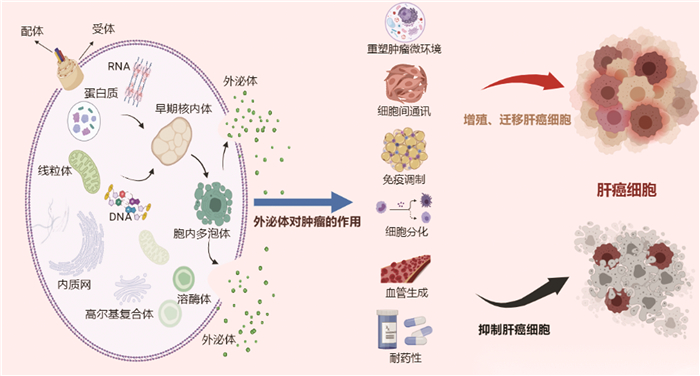外泌体在肝细胞癌发生发展中的作用及潜在临床价值
DOI: 10.3969/j.issn.1001-5256.2022.03.041
利益冲突声明:所有作者均声明不存在利益冲突。
作者贡献声明:罗业浩负责课题设计,资料分析及撰写论文;许栋涵、吕挺参与收集数据及修改论文;赵铁建、汪磊负责拟定写作思路,指导撰写文章并最后定稿。
Role and potential clinical value of exosomes in the development and progression of hepatocellular carcinoma
-
摘要: 外泌体具有促癌和抑癌的双重特性,其可通过改变肿瘤微环境,促进新生血管生成,调节上皮间质转化使肝癌细胞发生增殖、侵袭和转移。外泌体同样可调节各种生理和病理过程,从而对肝细胞癌具有调控作用,抑制肝癌细胞生长及转移,进而在临床诊断与治疗中发挥重要作用。指出通过免疫调节、重塑肿瘤微循环等可使外泌体成为有效的抗肿瘤治疗方式。Abstract: Exosomes have the dual characteristics of promoting and inhibiting cancer and can induce the proliferation, invasion, and metastasis of hepatoma cells by altering tumor microenvironment, promoting neovascularization, and regulating epithelial-mesenchymal transition. Exosomes can regulate hepatocellular carcinoma and inhibit the growth and metastasis of hepatoma cells by regulating a variety of physiological and pathological processes, thus playing an important role in clinical diagnosis and treatment. It is pointed out that exosomes may become an effective antitumor treatment method through immune regulation and remodeling of tumor microcirculation.
-
Key words:
- Exosomes /
- Carcinoma, Hepatocellular /
- Tumor Microenvironment
-
[1] RAEES A, KAMRAN M, ÖZKAN H, et al. Updates on the diagnosis and management of hepatocellular carcinoma[J]. Euroasian J Hepatogastroenterol, 2021, 11(1): 32-40. DOI: 10.5005/jp-journals-10018-1335. [2] KULIK L, EL-SERAG HB. Epidemiology and management of hepatocellular carcinoma[J]. Gastroenterology, 2019, 156(2): 477-491. e1. DOI: 10.1053/j.gastro.2018.08.065. [3] HWANG S, YANG YM. Exosomal microRNAs as diagnostic and therapeutic biomarkers in non-malignant liver diseases[J]. Arch Pharm Res, 2021, 44(6): 574-587. DOI: 10.1007/s12272-021-01338-2. [4] ZHOU B, XU K, ZHENG X, et al. Application of exosomes as liquid biopsy in clinical diagnosis[J]. Signal Transduct Target Ther, 2020, 5(1): 144. DOI: 10.1038/s41392-020-00258-9. [5] CHOI H, CHOI Y, YIM HY, et al. Biodistribution of exosomes and engineering strategies for targeted delivery of therapeutic exosomes[J]. Tissue Eng Regen Med, 2021, 18(4): 499-511. DOI: 10.1007/s13770-021-00361-0. [6] GUO J, ZHONG X, TAN Q, et al. miR-301a-3p induced by endoplasmic reticulum stress mediates the occurrence and transmission of trastuzumab resistance in HER2-positive gastric cancer[J]. Cell Death Dis, 2021, 12(7): 696. DOI: 10.1038/s41419-021-03991-3. [7] LUDWIG N, RAO A, SANDLESH P, et al. Characterization of systemic immunosuppression by IDH mutant glioma small extracellular vesicles[J]. Neuro Oncol, 2021. DOI: 10.1093/neuonc/noab153.[Onlineaheadofprint] [8] DENG L, ZHANG H, ZHANG Y, et al. An exosome-mimicking membrane hybrid nanoplatform for targeted treatment toward Kras-mutant pancreatic carcinoma[J]. Biomater Sci, 2021, 9(16): 5599-5611. DOI: 10.1039/d1bm00446h. [9] TANG Z, HE J, ZOU J, et al. Cisplatin-resistant HepG2 cell-derived exosomes transfer cisplatin resistance to cisplatin-sensitive cells in HCC[J]. PeerJ, 2021, 9: e11200. DOI: 10.7717/peerj.11200. [10] WANG H, ZENG X, ZHENG Y, et al. Exosomal circRNA in digestive system tumors: The main player or coadjuvants?[J]. Front Oncol, 2021, 11: 614462. DOI: 10.3389/fonc.2021.614462. [11] BAI X, LIU Z, SHAO X, et al. The heterogeneity of plasma miRNA profiles in hepatocellular carcinoma patients and the exploration of diagnostic circulating miRNAs for hepatocellular carcinoma[J]. PLoS One, 2019, 14(2): e0211581. DOI: 10.1371/journal.pone.0211581. [12] INOMATA K, YAGI H, HIBI T, et al. Long-term outcomes of living donor liver transplantation after locoregional treatment for hepatocellular carcinoma: An experience from a single institute[J]. Surg Today, 2021, 51(3): 350-357. DOI: 10.1007/s00595-020-02095-3. [13] NEGGERS JE, PAOLELLA BR, ASFAW A, et al. Synthetic lethal interaction between the ESCRT paralog enzymes VPS4A and VPS4B in cancers harboring loss of chromosome 18q or 16q[J]. Cell Rep, 2021, 36(2): 109367. DOI: 10.1016/j.celrep.2021.109367. [14] HARTMANN K, GOTLIB J, AKIN C, et al. Midostaurin improves quality of life and mediator-related symptoms in advanced systemic mastocytosis[J]. J Allergy Clin Immunol, 2020, 146(2): 356-366. e4. DOI: 10.1016/j.jaci.2020.03.044. [15] CUI FL, MAHMUD AN, XU ZP, et al. VASN promotes proliferation of prostate cancer through the YAP/TAZ axis[J]. Eur Rev Med Pharmacol Sci, 2020, 24(12): 6589-6596. DOI: 10.26355/eurrev_202006_21644. [16] LIANG W, GUO B, YE J, et al. Vasorin stimulates malignant progression and angiogenesis in glioma[J]. Cancer Sci, 2019, 110(8): 2558-2572. DOI: 10.1111/cas.14103. [17] CHAI ZT, ZHANG XP, AO JY, et al. AXL Overexpression in tumor-derived endothelial cells promotes vessel metastasis in patients with hepatocellular carcinoma[J]. Front Oncol, 2021, 11: 650963. DOI: 10.3389/fonc.2021.650963. [18] PENG C, YE Y, WANG Z, et al. Circulating microRNAs for the diagnosis of hepatocellular carcinoma[J]. Dig Liver Dis, 2019, 51(5): 621-631. DOI: 10.1016/j.dld.2018.12.011. [19] YUAN C, NI L, ZHANG C, et al. Ephrin B2 mediates high glucose induced endothelial-to-mesenchymal transition in human aortic endothelial cells[J]. Cardiovasc Diagn Ther, 2020, 10(4): 778-785. DOI: 10.21037/cdt-20-299. [20] ARCUCCI V, STACKER SA, ACHEN MG. Control of gene expression by exosome derived non-coding RNAs in cancer angiogenesis and lymphangiogenesis[J]. Biomolecules, 2021, 11(2): 249. DOI: 10.3390/biom11020249. [21] SASTRE-GARAU X, DIOP M, MARTIN F, et al. A NGS-based blood test for the diagnosis of invasive HPV-associated carcinomas with extensive viral genomic characterization[J]. Clin Cancer Res, 2021. DOI: 10.1158/1078-0432.CCR-21-0293.[Online ahead of print] [22] XIE XW, JIANG SS, LI X. CLEC3B as a potential prognostic biomarker in hepatocellular carcinoma[J]. Front Mol Biosci, 2020, 7: 614034. DOI: 10.3389/fmolb.2020.614034. [23] YE M, WANG S, SUN P, et al. Integrated MicroRNA expression profile reveals dysregulated miR-20a-5p and miR-200a-3p in liver fibrosis[J]. Biomed Res Int, 2021, 2021: 9583932. DOI: 10.1155/2021/9583932. [24] TIAN W, LI J, WANG Z, et al. HYD-PEP06 suppresses hepatocellular carcinoma metastasis, epithelial-mesenchymal transition and cancer stem cell-like properties by inhibiting PI3K/AKT and WNT/β-catenin signaling activation[J]. Acta Pharm Sin B, 2021, 11(6): 1592-1606. DOI: 10.1016/j.apsb.2021.03.040. [25] YU H, HE J, SU G, et al. Fluid shear stress activates YAP to promote epithelial-mesenchymal transition in hepatocellular carcinoma[J]. Mol Oncol, 2021, 15(11): 3164-3183. DOI: 10.1002/1878-0261.13061. [26] SOROP A, IACOB R, IACOB S, et al. Plasma small extracellular vesicles derived miR-21-5p and miR-92a-3p as potential biomarkers for hepatocellular carcinoma screening[J]. Front Genet, 2020, 11: 712. DOI: 10.3389/fgene.2020.00712 [27] LI Y, XING BX, WANG YH, et al. CTHRC1 promotes growth, migration and invasion of trophoblasts via reciprocal Wnt/β-catenin regulation[J]. J Cell Commun Signal, 2022, 16(1): 63-74. DOI: 10.1007/s12079-021-00625-3. [28] LIU Y, YANG Y, WANG T, et al. Long non-coding RNA CCAL promotes hepatocellular carcinoma progression by regulating AP-2α and Wnt/β-catenin pathway[J]. Int J Biol Macromol, 2018, 109: 424-434. DOI: 10.1016/j.ijbiomac.2017.12.110. [29] KEERTHIVASAN S, ȘENBABAOǦLU Y, MARTINEZ-MARTIN N, et al. Homeostatic functions of monocytes and interstitial lung macrophages are regulated via collagen domain-binding receptor LAIR1[J]. Immunity, 2021, 54(7): 1511-1526. e8. DOI: 10.1016/j.immuni.2021.06.012. [30] SANCHEZ JI, JIAO J, KWAN SY, et al. Lipidomic profiles of plasma exosomes identify candidate biomarkers for early detection of hepatocellular carcinoma in patients with cirrhosis[J]. Cancer Prev Res (Phila), 2021, 14(10): 955-962. DOI: 10.1158/1940-6207.CAPR-20-0612. [31] KIMURA S, NAGANUMA S, SUSUKI D, et al. Expression of microRNAs in squamous cell carcinoma of human head and neck and the esophagus: miR-205 and miR-21 are specific markers for HNSCC and ESCC[J]. Oncol Rep, 2010, 23(6): 1625-1633. DOI: 10.3892/or_00000804. [32] KIM OK, NAM DE, HAHN YS. The Pannexin 1/Purinergic receptor P2X4 pathway controls the secretion of microrna-containing exosomes by HCV-infected hepatocytes[J]. Hepatology, 2021, 74(6): 3409-3426. DOI: 10.1002/hep.32042. [33] CHUAMMITRI P, VANNAMAHAXAY S, SORNPET B, et al. Detection and characterization of microRNA expression profiling and its target genes in response to canine parvovirus in Crandell Reese Feline Kidney cells[J]. Peer J, 2020, 8: e8522. DOI: 10.7717/peerj.8522. [34] SUN L, DONG S, DONG C, et al. Predictive value of plasma miRNA-718 for esophageal squamous cell carcinoma[J]. Cancer Biomark, 2016, 16(2): 265-273. DOI: 10.3233/CBM-150564. [35] JIANG L, LI X, CHENG Q, et al. Plasma microRNA might as a potential biomarker for hepatocellular carcinoma and chronic liver disease screening[J]. Tumour Biol, 2015, 36(9): 7167-7174. DOI: 10.1007/s13277-015-3446-7. [36] WANG K, ZHANG Y, LIN Q, et al. Serum exosome microRNA-218 expression level and prognosis of liver cancer[J]. Trauma and Crit Medicine, 2020, 8(4): 286-289, 293. DOI: 10.16048/j.issn.2095-5561.2020.04.18.万科, 张易, 林强, 等. 血清外泌体微小核糖核酸-218表达水平与肝癌预后研究[J]. 创伤与急危重病医学, 2020, 8(4): 286-289, 293. DOI: 10.16048/j.issn.2095-5561.2020.04.18. [37] QU Z, WU J, WU J, et al. Exosomal miR-665 as a novel minimally invasive biomarker for hepatocellular carcinoma diagnosis and prognosis[J]. Oncotarget, 2017, 8(46): 80666-80678. DOI: 10.18632/oncotarget.20881. [38] CHENG J, CHEN Y, ZHAO P, et al. Downregulation of miRNA-638 promotes angiogenesis and growth of hepatocellular carcinoma by targeting VEGF[J]. Oncotarget, 2016, 7(21): 30702-30711. DOI: 10.18632/oncotarget.8930. [39] YU H, HAN R, SU J, et al. Multi-marker diagnosis method for early hepatocellular carcinoma based on surface plasmon resonance[J]. Clin Chim Acta, 2020, 502: 9-14. DOI: 10.1016/j.cca.2019.12.007. [40] ZENG YL, GUO ZY, SU HZ, et al. Diagnostic and prognostic value of lncRNA cancer susceptibility candidate 9 in hepatocellular carcinoma[J]. World J Gastroenterol, 2019, 25(48): 6902-6915. DOI: 10.3748/wjg.v25.i48.6902. [41] QURESHI A, MICHEL M, LERNER J, et al. Evolving therapeutic strategies for advanced hepatocellular carcinoma[J]. Expert Opin Pharmacother, 2021, 22(18): 2495-2506. DOI: 10.1080/14656566.2021.1953473. [42] BRUIX J, CHAN SL, GALLE PR, et al. Systemic treatment of hepatocellular carcinoma: An EASL position paper[J]. J Hepatol, 2021, 75(4): 960-974. DOI: 10.1016/j.jhep.2021.07.004. [43] WANG LT, LIU KY, CHIOU SS, et al. Phosphorylation of intestine-specific homeobox by ERK1 modulates oncogenic activity and sorafenib resistance[J]. Cancer Lett, 2021, 520: 160-171. DOI: 10.1016/j.canlet.2021.07.011. [44] SUN X, LIN F, SUN W, et al. Exosome-transmitted miRNA-335-5p promotes colorectal cancer invasion and metastasis by facilitating EMT via targeting RASA1[J]. Mol Ther Nucleic Acids, 2021, 24: 164-174. DOI: 10.1016/j.omtn.2021.02.022. [45] TANG J, LI Y, LIU K, et al. Exosomal miR-9-3p suppresses HBGF-5 expression and is a functional biomarker in hepatocellular carcinoma[J]. Minerva Med, 2018, 109(1): 15-23. DOI: 10.23736/S0026-4806.17.05167-9. [46] ISEDA N, ITOH S, YOSHIZUMI T, et al. Lymphocyte-to-C-reactive protein ratio as a prognostic factor for hepatocellular carcinoma[J]. Int J Clin Oncol, 2021, 26(10): 1890-1900. DOI: 10.1007/s10147-021-01985-x. [47] SHI S, RAO Q, ZHANG C, et al. Dendritic cells pulsed with exosomes in combination with PD-1 antibody increase the efficacy of sorafenib in hepatocellular carcinoma model[J]. Transl Oncol, 2018, 11(2): 250-258. DOI: 10.1016/j.tranon.2018.01.001. [48] ZHU S, ZHU Y, WANG Q, et al. CHK methylation is elevated in colon cancer cells and contributes to the oncogenic properties[J]. Front Cell Dev Biol, 2021, 9: 708038. DOI: 10.3389/fcell.2021.708038. [49] MEUNIER L, HIRSCH TZ, CARUSO S, et al. DNA methylation signatures reveal the diversity of processes remodeling hepatocellular carcinoma methylomes[J]. Hepatology, 2021, 74(2): 816-834. DOI: 10.1002/hep.31796. [50] JIANG W, LI Y, ZHANG S, et al. Association between cellular immune response and spleen weight in mice with hepatocellular carcinoma[J]. Oncol Lett, 2021, 22(2): 625. DOI: 10.3892/ol.2021.12886. [51] XING M, WANG X, KIKEN RA, et al. Immunodiagnostic biomarkers for hepatocellular carcinoma (HCC): The first step in detection and treatment[J]. Int J Mol Sci, 2021, 22(11): 6139. DOI: 10.3390/ijms22116139. -



 PDF下载 ( 2406 KB)
PDF下载 ( 2406 KB)


 下载:
下载:


